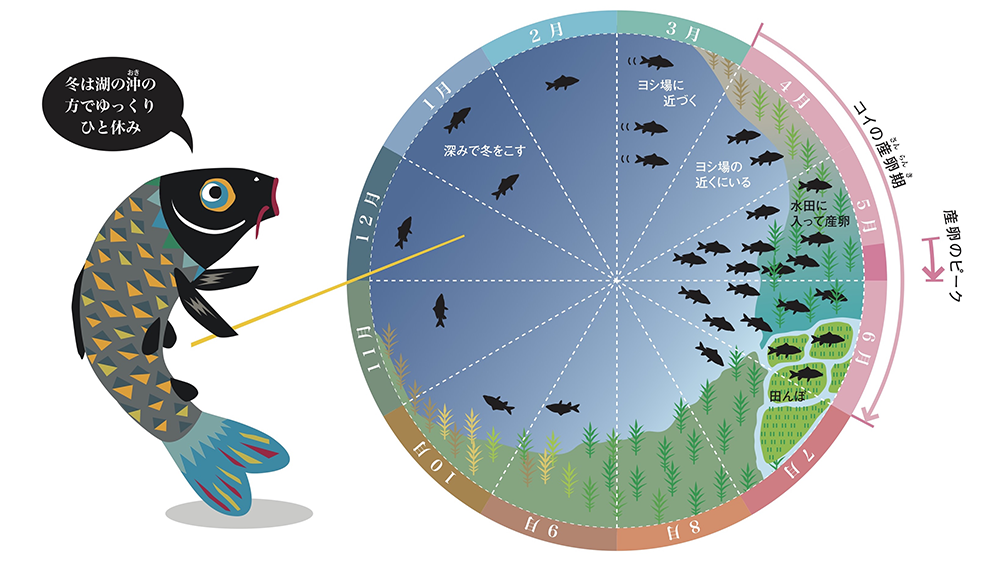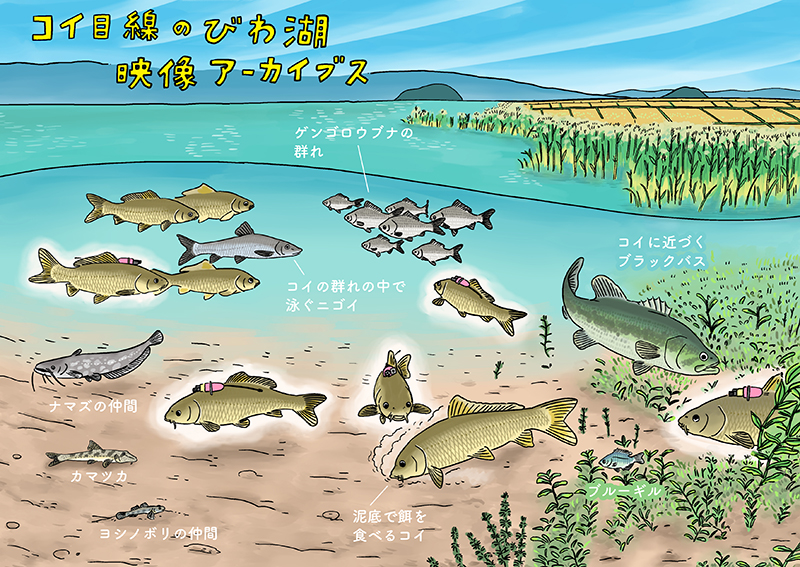Carps in Lake Biwa
Two types of common carp in Lake Biwa
Since the 18th century, two different types of common carp have been recognized in natural waters of Japan: a ‘wild type’, which has an elongated body shape, and a ‘domesticated type’, which has a greater body height than the wild type. Our recent studies using mitochondrial/nucleus DNA analyses have revealed that these two types of carp differ in origin; the former being a Japanese native strain and the latter being an introduced Eurasian strain. Today, these two strains have hybridized in most lakes in Japan, yet a relatively pure ‘native’ population remains in offshore deep-water (> 20 m) of Lake Biwa. Currently, the Japanese native carp in Lake Biwa is ranked as a ‘Threatened Local Population (LP)’ in the 5th version of the Japanese Red Data List, and a ‘Near Threatened (NT)’ in the Red Data Book of Shiga Prefecture 2015.
Lifecycle of Japanese native carps in Lake Biwa
A lifecycle of Japanese native carp in Lake Biwa has yet to be understood. Its seasonal movement is roughly understood as follows:
- Spring (Mar-Jun):
- Spawn in reed zones, channels, or paddy fields.
- Summer to Autumn (Jul-Nov):
- Feed around the coastal area.
- Winter (Dec-Feb):
- Migrate to offshore deep-water and stay there until the next spring.
Amongst these, only the information during spring comes from direct observation, the lifecycle from summer to winter is just a speculation based on limited information obtained through fisheries.

Illustration by Aki Ishibashi.
What we can tell from their shape
Two strains significantly differ in their body shapes, and their morphological differences seem to reflect their behavior. Comparative analyses on their morphological traits have revealed that the Japanese native carp have more elongated bodies, shorter guts, and thicker valves on pneumatic ducts than the introduced Eurasian carp. Each of these characteristics suggests that the native carp are fast swimmers and carnivorous rather than herbivorous as herbivorous fish tend to have longer intestines. Furthermore, the thicker valves on pneumatic ducts of the native carp contribute to retaining buoyancy by preventing leaks of gases from their swim bladder, allowing them to move more quickly from the deep area to the shallow area. The native carp is therefore regarded as active swimmers that forage on small aquatic animals in offshore waters of Lake Biwa. We are now using animal-borne devices to obtain behavioral data of the native carp in the wild to reveal its real-life inferred from their morphology.
Interactions between creatures
We can observe various living organisms through a carp-mounted video. For example, a school of Japanese crucian carp feeding on planktons in the water column, a common carp searching for prey on the sandy bottom, or tiny gobies swimming near the bottom, and so on. These records of wild animals and their behaviors under natural condition would help us understand a diverse ecosystem in the lake.
